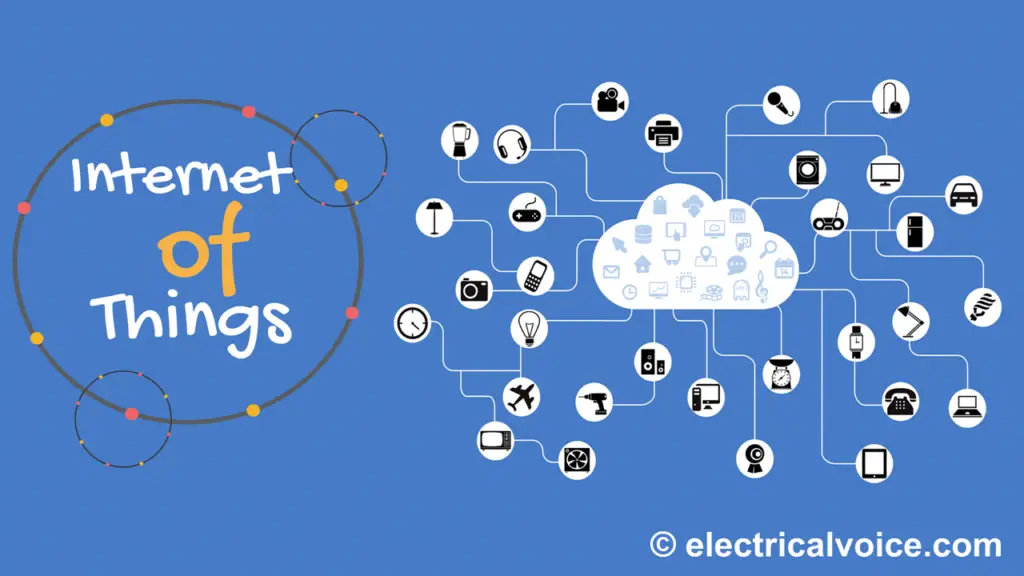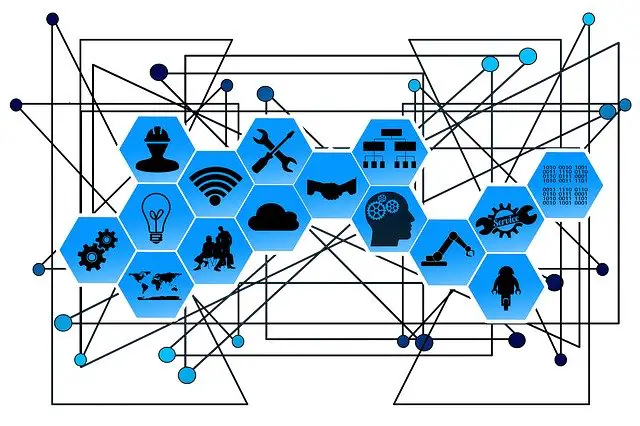Internet of Things (IoT) is the networking of smart devices (electronics, mechanical and digital machines) that have unique identifiers that can collect data from the external world through sensors and feed them to databases for further processing.
The advancements made in the IoT domain in recent years have changed the level of services they offer and practically change the way people lead their daily lives. Advancements in healthcare, power, gene therapies, agriculture, smart homes and smart cities are just a very few of the categorical examples where IoT is strongly established.

Examples of the Internet of Things are connected vehicles, connected security systems, electronic and electrical appliances in household and commercial areas, smartwatches, speaker systems, coffee vending machines etc.
The term IoT has ‘internet’ because it transfers data to a network and particularly the Internet. The term ‘thing’ refers to a physical object which has a unique identifier and has the ability to transfer over the internet.
Characteristics of IoT
• Sensors – Sensors are an integral part of any IoT architecture. It is because of these components that the system is able to interact with the real world and collect the required information. Sensors can convert any physical quantity (temperature, water moisture, heat, pressure etc) into a measurable electrical signal. Some commonly used sensors in IoT are temperature sensor, Pressure sensor, proximity sensor, Accelerometer, IR sensor, Gas sensor, Optical sensor, Smoke sensor etc.
• Connectivity – IoT devices must be connected over a network in order to share the data. New enabling technologies for networking make network readily available for IoT technologies. Networks can be based on a smaller and cheaper scale, yet it can be practical. Small networks can be formed between their system devices.
• Artificial Intelligence – When Artificial Intelligence is combined with the Internet of things, we get AIoT i.e. Artificial Intelligence of Things where IoT is the digital nervous system and the AI is the brain of the system. AI induce and simulate intelligent behaviour in devices making it more ‘smart’. AI has the capability to provide analytics which can extract meaningful data.
• Low power embedded system – Less battery consumption, high performance are the key metrics of design of electronics in the IoT devices.
IoT Enablers
• RFID – Radio Frequency Identification System is based on wireless technology which makes use of radio waves to identify objects equipped with RFID tags without using the internet. For example, in a healthcare system, RFID tags can be attached to the patients and all the information related to the patient can be tracked by punching their RFID tag against the RFID scanner.
• Sensors – These are electronic devices that can sense a real-world change in physical quantities and convert them to corresponding electrical signal.
• Nanotechnology – At industrial and consumer levels the massive amount of information is recorded and these data are managed by interconnected nanodevices.
Big Data and IoT
Big Data is a technology that manages huge sets of structured or unstructured data and analyses them to propose a business trend. Usually, a system of connected devices in IoT record a huge amount of raw data especially in the industrial and commercial sector.
These data must be stored somewhere in an ordered manner so that these data can be analysed and processed correctly and efficiently. This is where Big Data comes into the picture.
Big Data provides tools like Hadoop, MapReduce and Spark to analyse these data. It is not just that they are interrelated to each other but they also impact each other in a lot of ways.
More the IoT grows, it places more performing capability demands on Big Data technology. So, it demands more advanced and innovative solutions to handle the huge volume of IoT data.
IoT and Big Data are both interdependent and together provides many benefits to any organisation. For example, sale prediction, find unseen patterns, find hidden profits or loss etc.
Benefits of IoT and Big Data for companies in different sectors
• Improve future e-health system – Big data can transform hypothesis-driven research into data-driven research. IoT will help to analyse the correlation between the sensor data and existing big data. Remote diagnosis will be possible with a better understanding of the disease and hence will lead to innovative solutions.
• Benefits to the manufacturing sector – Significant data from machines can be collected remotely by the IoT sensor devices. Any fault in the machine can be determined beforehand with the help of big data concepts. Other data analysis can help them to prepare future trends in the market. This can greatly boost up the business.
• Advantages in the transport industry – IoT enablers like RFID and sensors installed on the vehicles can help track the assets on the go around the world. These track records also provide various other information about the vehicle like fuel efficiency and efficiency of the driver etc.
Cloud and IoT
Cloud computing and IoT work in a collaborative manner to make the everyday task easier to achieve. IoT generates a lot of meaningful data and it is the cloud that is responsible to make these data travel correctly to their destinations.
Many giant techies like Amazon, Google, Alibaba are already making use of Cloud technology and making machine learning tools to deliver a wider range of solutions and services. Just like cloud computing is built on the design metrics of speed and scale, IoT applications are built on the principle of mobility and widespread network.
Below are mentioned some pointers to demonstrate as to why and how cloud computing technology is inevitable in IoT’s success.
• Remote processing – Apart from collecting and distributing information from conventional home appliances cloud gives the power to IoT devices to spread its wings over a widespread network remotely. Now the infrastructure boundaries are no limitations to IoT.
• Security and Privacy – The efficiency of IoT is incomplete without security. Cloud has made IoT more secure with security and privacy controls on the IoT data. Authentication and encryption protocols by the cloud are a saviour to IoT data to protect them from external threats and hacking.
• Inter devices communication – Many cloud APIs allow easy linking to devices like smartphones. This eases devices to communicate with each other and not just us.
Cloud technology greatly enhances the IoT capability but there are also certain challenges which one must keep in mind while designing IoT – cloud solution. For example, handling massive data in the cloud, networking protocols of heterogeneous devices and timely transfer of sensor data over the network etc.
Nanotechnology and IoT
A huge amount of data generated by IoT devices is a challenge to process. Nanotechnology can be used to create powerful processors and computing devices that can collect, analyze and report on the IoT data. Nanotechnology can also be useful to create battery systems that can help IoT devices to function without being charged.
Sophisticated nanoscale embedded devices like telephones, televisions and health tracking devices – all use miniaturized antenna and receivers to enable communication and data sharing. So, nanotechnology complement IoT in many ways, from manufacturing nanosized IoT devices to the nano processors that can compute and process IoT data efficiently.
Applications of IoT
IoT finds application in almost all sectors ranging from household appliances to large industries and organizations. It not only provides mere communication to household devices remotely but also helps organizations to streamline their operations.

• Government sector – IoT enables the safe and secure movement of data efficiently over a network which helps improved law enforcement, city planning, disaster management, defence and economic management.
• Home automation – Remote access of all household appliances is possible by just a touch on your mobile application. This is all possible by advance features of IoT. It has improved human living standard and added to his comfort level.
• Healthcare – Today, almost all health monitoring and diagnostic equipment are IoT enabled. This enables even remote diagnosis of patients and treatment. Hence, IoT has enhanced the quality and standard of healthcare services.
• Engineering and technology – IoT technology has helped build sophisticated engineering infrastructure like world-class hospitals, airports, bridges etc. It also helps other technologies like drones and nanotechnology to flourish and improve.
• Industry – Machine automation leads IoT to find its application in the industrial sector for remote monitoring and processing. Robotics is another field which makes IoT come into the picture.
• Marketing and advertising – When customers buy a product containing a sensor or any IoT enabler, data can be collected from them which can tell about the product sale and quality. Hence businesses can draw market trends for this product and improve on their strategy.
• Commercial agriculture – With the use of IoT devices farmers can monitor their fields and protect their crops from unforeseen conditions. They can also use IoT and drone technologies for the spread of fertilizers over a wider region.
• Disaster management – Effective forecasting of weather requires high details, better accuracy and flexible instrument type. IoT devices help forecasting giving minute details and early response to prevent loss of property and life. New IoT advances promise more fine-grained data, better accuracy and flexibility.
Author
Anupama kumari
M.Tech (VLSI Design and Embedded system)
BS Abdur Rahman University

Best article I read about the Internet of Things.